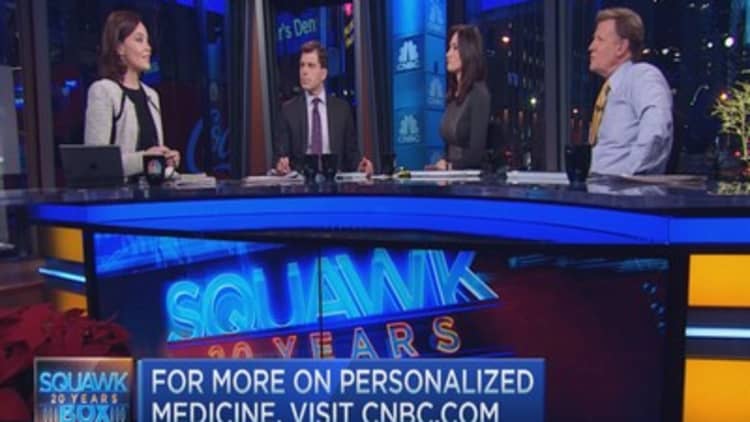
Around the same time I traveled to Boston to have my genome sequenced, I deposited 2 milliliters, or about half a teaspoon, of spit in a plastic tube, sealed it up, and dropped it in a mailbox. While I got a whole genome sequence with Illumina, I was also going to get what is called the 23andMe experience.
At the time, this cost just $99. It was before 23andMe's October announcement that it was back on the market providing certain health and wellness information, at a new price of $199. When I submitted my sample, 23andMe was only providing ancestry data.
This was because in 2013, the Food and Drug Administration ordered the Silicon Valley company, which takes its name from the 23 pair of chromosomes found in a human cell, to stop providing health information that it said violated the Federal Food, Drug and Cosmetic Act. The FDA warned that by providing information about an individual's genetic risk for certain diseases, or the way their genes indicated they may respond to different drugs, people might make dangerous medical decisions without the advice of a physician.
The new service has FDA authorization, though it doesn't provide as much health information as the original. It offers carrier status — a measurement of genetic risk for passing predisposition for disease onto our children — what it calls "wellness" characteristics, including lactose intolerance, and traits like eye color. That's in addition to the ancestry data.
With the ancestry test, I found only limited elements of interest. I knew my family was of European descent, and the test confirmed that all but 0.3 percent of my ancestors came from that part of the world (that 0.3 percent of East Asian and Native American descent, though, was fairly interesting).
The test also told me I have more Neanderthal variants than 94 percent of 23andMe customers. Embarrassing, but true. Luckily, my Neanderthal ancestry accounts for less than 4 percent of my overall DNA.
I turned out to be a carrier of none of the 36 diseases 23andMe tests for — maladies like cystic fibrosis and something called maple syrup urine disease (yes, this is really what it's called, and it's worse than it sounds). This was a relief. It means that even if my partner did carry a mutation for those anomalies, our children wouldn't be at risk for the disease (though my Illumina whole genome sequencing turned up three others I do carry).
Some of the most interesting results were in the wellness and trait categories. Apparently, I am lactose intolerant; 23andMe says I have a genetic signature suggesting I likely do not produce the enzyme lactase. The cheese shop down the street from my apartment would beg to differ.
I spoke with 23andMe's vice president of business development, Emily Drabant Conley, about this. She said it's possible my body has developed other ways to process lactose, potentially through my microbiome — the collection of trillions of bacteria that live in our guts — further emphasizing that our genes aren't our destiny. My body stubbornly found a way to consume cheese, and I'm so glad it did.
The beauty of what 23andMe offers is in its presentation of complex genetic information on a consumer-facing, user-friendly website. Mindful of its wrist-slap from the FDA, the company goes to lengths to ensure its customers understand the information they're being provided. Users read a tutorial on the genetics of carrier traits before getting to see those results, for example.
There's also a tremendous research element to 23andMe; more than 80 percent of customers opt in to participating, filling out surveys asking about everything from how many wrinkles they have to whether they prefer talking or listening.
"The hope is by really understanding the genetic basis of the disease, we can help people predict if they're at risk for something, and then what, if anything, they can do within the environment that they're in to potentially alter those risks," 23andMe CEO Anne Wojcicki said in an interview.
The company also provides customers with information about how they compare with everyone else, a fun incentive to keep answering survey questions.
"People love it," Wojcicki said. "For instance, I've always been proud I have no cavities, and I know that 7 percent of the 23andMe database doesn't have any cavities."
I also have no cavities.
At $199, 23andMe's test is a bargain compared with Illumina's $2,900 Understand Your Genome offering. That's because 23andMe sequences only a part of the genome, Wojcicki explained.
"What 23andMe does is we genotype," she said. "So we know that any two people differ in a very tiny percentage of their DNA, so 23andMe looks at those differences."
Sequencing the entire genome right now, Wojcicki said, "we probably look at it as more of a luxury item at this time. ... You can get so much value just from being genotyped."









